|
|
|
|
Products mentioned in this Article
--None--
|
|
|
|
|
|
|
|
|
 |
|
|
|
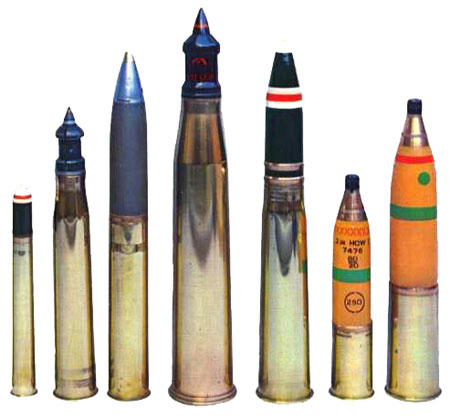
British Tank rounds left to right: 2pdr, 6pdr APDS, 75mm (Sherman), 17pdr APDS, 77mm (Comet), 3" and 95mm CS.
|
Anti-tank Ammunition –
what do all those letters mean?
By Ken Natt
When I was writing up my entry for the scenario competition I found myself glibly referring to APCBC ammunition, and I suddenly thought, “I wonder if anyone knows what the hell I am talking about.” With this in mind I asked a few of our club members (The Hartlepool Wargames Society – no period or scale too weird), and on the whole I got blank looks. So here is a short primer (geddit?) into the specifics of the unpleasantness we have our troops expend downrange at the opposition crawling around in their tin boxes. I will try to keep it simple, so long lectures on muzzle velocity and BHNs are out, but if it does get a bit confusing it is because, well, it is. Sorry.
|
|
Carts and horses, or rather guns
Before I go any further it may be useful to explain the way guns are classified, otherwise it may get confusing later. Guns have a calibre and a length expressed as a number of that calibre, so for instance a German 75mm as mounted on an early PzIV or a SdKfz 251\9 is known as a 7.5cm L24 (L for length), the gun barrel is 7.5cm wide, and is 24x7.5cm long. This can also be expressed as 75\24. This gun in FoW is called a “short” 75. As a rule of thumb, longer guns develop more muzzle velocity, so more range and better penetration. Added to this, when a round is travelling faster it gets there quicker, so long guns are also generally more accurate. Finally, big rounds are less effected by cross wind and other environmental factors so also tend to be more accurate.
Back to Basics
In 1939 (which for our American readers is when the war really started)
(Ken is English ~ Ed.), there were basically only two views as to what
you should shoot tanks with. These were:
|
|
AP – Armour Piercing or solid shot. These as the name suggests was simply a hunk of metal that, assuming sufficient velocity was imparted, would punch through the target armour and then ricochet around inside doing unpleasant things to the crew and any other soft or delicate bits.
This was the main anti tank ammunition of the British, and was also
used on and off by the other nations, barring the Germans who always
used APHE.
|
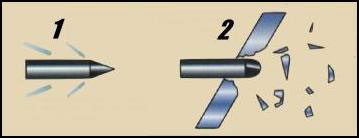
|
| It was adequate against soft vehicles as long as it hit something breakable, but pretty much useless against guns and infantry. |
|

|
APHE – Armour Piercing High Explosive or AP shell. This was a variation on the AP shot theme where the ammunition contained a base fused explosive charge. The idea was that once inside the target the shell would explode, doing more damage than the equivalent solid AP. This works well in theory but has a few practical drawbacks. Firstly, as the explosives and fuse weigh less than the equivalent solid shot, they carry less momentum and so have a proportionally poorer penetration than their solid cousins. The second problem is that the fuse needs to detonate correctly otherwise the explosive value is wasted, and this was a difficult technical problem to solve at the time. Many APHE rounds simply failed to go off. Lastly, as most nations were initially using quite small anti tank rounds of about 37-45mm, the actual amount of explosive inside the shell was pretty minimal. APHE was used by the Germans on guns of over 20mm and Russians on guns of 37mm plus, and also by the US. The Germans, being a methodical race went so far as to employ the idea in their anti tank rifle rounds but replaced the HE with a small phial of tear gas. Unfortunately the amount was so small that no one seems to have noticed. One other advantage of APHE was that it maintained a limited usefulness against infantry and similar targets.
All the above was fine until tanks with thicker and \ or face hardened armour (used only by the Germans) started to appear. The original response was simply to make guns longer, increase muzzle velocities and harden the projectiles, and then physics started to kick. It was discovered that the shock of impact between the shot and the armour was causing the shot to shatter before penetrating. The main quoted culprit seems to have been the poor 2Pdr (40mm L52), although everyone suffered to one extent or another.
|
|
A solution was needed, and it came along with: -
APC - Armour Piercing Capped. Here a nose cone (or cap) of softer metal was fixed to the front of the solid shot. When this struck the target armour the shock was transferred away from the tip of the round to the neck, thus helping prevent shatter. An added bonus was that it was found that the softer caps improved “grip” against sloped armour, squashing on impact to allow the main shot to penetrate rather than glancing off. Even better, some felt that as the soft cap vaporised it helped lubricate the main round through. The only problem was that the new nose caps were a ballistic nightmare, being flatter and less streamlined than the uncapped round, so accuracy suffered. This lead to:
|
APCBC - Armour Piercing Capped Ballistic Capped. This took the APC idea one step further and added a light streamlined false cap over the soft cap, regaining the proper ballistic shape.
|

|
|
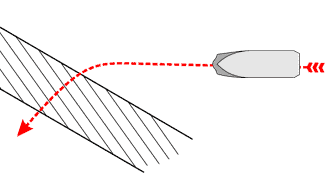
|
This was the end of the line for full calibre AT rounds, but was soon joined by what we would now call sub calibre rounds. Used by Britain, Germany and the US.
Left: APBC in action.
|
|
APBC – Armour Piercing Ballistic Capped. This is the Russian equivalent to APCBC. This round had a light ballistic cap covering a blunt nosed projectile. This round was less prone to shatter than a standard AP due to the shape of the nose.
APCR or HVAP – Armour Piercing Composite Rigid or High Velocity Armour Piercing. Different names but the same idea. These rounds were the result of some bright spark working out that you could get more oomph out of an anti tank shot by increasing the density of the penetrating bit (using tungsten) and encasing it in a lighter outer full bore cover. The shape of the round led it to being called “arrow shot” by the Russians. The Germans perfected this with their Panzergranate 40 (PzGr40) round, which they found went through T34s like a hot knife through butter, and with it ruled the battlefield for a couple of months during late 1942, then they ran out of tungsten!
This was less of a problem for the US and USSR, who both continued to use their versions until the war ended. The other drawback with the APCR\HVAP was that the round was lighter than a normal round but still had the same cross section as a result of the cover so these rounds lost velocity over distance faster than normal rounds. This means they lost penetration and accuracy quickly, to the point that you were better off with a “normal” APCBC at anything over 800\1000 yards.
|
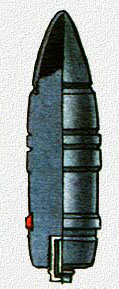
|
|

|
The British took a look at APCR, but thought they could go one better,
and produced APDS, (see later) but before we go there, there is one
other interesting development that needs looking at, squeeze bores.
|
APCNR – Armour Piercing Composite Non Rigid. Squeeze bores were another clever idea at getting more velocity from your guns. The barrels narrowed slightly from breach to muzzle, and the sub calibre tungsten shots again had full bore covers, but this time they were thin “skirts”. As the round travelled down the barrel the skirts were squeezed in, more pressure was exerted over the smaller area producing increasing muzzle velocity. There were two types, cone bores and squeeze bores, cone bores had a regular taper for the length of the barrel, squeeze bores only a part was tapered, usually the end. For a while this looked like a great idea, and the Germans deployed several versions, the 28mm being common but the 75mm version was a fantastic performer, then of course the tungsten ran out. The other user was the British, who late in the war fitter a squeeze bore adapter to the 2Pdr (40mmL52), and called it “Littlejohn”. It worked well enough, but by then the only vehicles still left with a 2Pdr were armoured cars and the odd airborne tank, who frankly were not too interested in shooting it out with tanks, even if they could in theory get results. The big drawback with APCNR (apart from the tungsten running out) was that while it produced stellar results against tanks, you needed to reengineer your HE rounds in a similar way or they wouldn’t get down the barrel. This problem meant that Littlejohn equipped Daimler A\Cs could not fire HE, so some units removed the adaptors, possibly the only time anyone thought 2Pdr HE was worth having!
|
|
APDS or SVDS – Armour Piercing Discarding Sabot (or Super Velocity Discarding Sabot as originally called). Here the tungsten penetrator was encased in a sheath of light metal as in APCR, but with APDS the sheath (sabot – French for shoe – don’t ask just trust me as it gets complicated here) fell apart as the shot left the muzzle, leaving the narrow cross section penetrator with the same high velocities as APCR but without the drag caused by the cover.
APDS was a real tank killer, going farther and faster than any similar anti tank round, and gave some truly spectacular improvements in penetration power, for example when APDS was issued to 6pdr guns for D-Day, it effectively doubled their penetrating power.
|
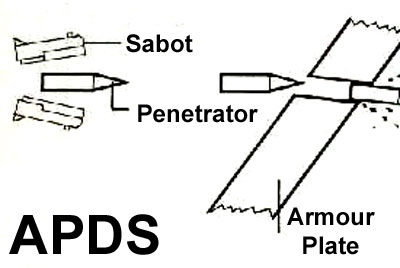
|
|

|
Tigers could be killed out to 500 yards and the
17pdr APDS available from August 1944 would go through ANYTHING (just
about). There were problems however. Firstly, it was a secret, so not
everyone was told how to use it or had time to train with it.
APDS has such a high muzzle velocity that the round gets to the target
a lot quicker than standard AP.
|
|
The result is that the “aim off” (how
far ahead of a moving target you aim to account for the time required
for the round to arrive – aka deflection) required is much less.
Similarly, the faster moving round had a much flatter trajectory, and
as the gun sights did not have a setting for APDS troops had to try and
guess both the range and the deflection.
In the heat of battle they often got it wrong and missed. The other problem was with the ammunition itself, which seems to have suffered from bad quality control. In some batches the sabot failed to separate cleanly, which could lead to wild inaccuracies. This seems to have been corrected as the war closed, and APDS in its current versions is still the first choice for anti tank guns today.
HEAT - High Explosive Anti Tank. Last of the true anti tank rounds, HEAT uses the shaped charge principle to create a blowtorch effect that is very good against armour plate, burning through the target and spraying molten metal about inside – very nasty.
During WW2 everyone used HEAT rounds to one extent or another, but there were some problems. Firstly, no-one fully understood the exact science of how shaped charges formed the blowtorch, so although the penetration is in theory proportional to the warhead diameter, in practice it was never quite that simple and performance varied widely. Secondly, it was found that HEAT is best delivered at low velocity to allow the blowtorch to form, so it is not too useful for tanks which have long guns designed to maximise muzzle velocity. For these reasons you tend to find HEAT warheads in the hands of the infantry (Bazookas, Panzerfausts, PIATs etc) or with artillery units.
|

|
|
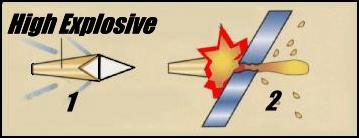
|
The Germans used a lot of HEAT rounds and were probably the first to use them, but found that the troops issued with them were none too happy because having a relatively slow round meant less accuracy, so about 600 yards seems to be about maximum engagement range with any chance of a hit. Another less publicised problem with HEAT rounds was that they could cause relatively little damage inside unless they penetrated cleanly and hit something flammable.
|
|
The Russians called the spot where a Panzerfaust
hit but did not get all the way through a “witches kiss”, as it would
leave a small spot of burnt paintwork on the inside.
HE – High Explosive. Not strictly an anti tank round, but still worth a mention. Tanks are designed to withstand HE hits, but if you get a direct hit from a heavy round then you can have drastic results. Probably the main exponents of this approach were the Soviets, who not only issued every gun with some form of anti tank round, they were also happy to shoot HE at tanks. 152mm HE will spoil any ones day.
Availability
The special tungsten rounds were never widely available.
|
|
Tanks would have only a few APCR\HVAP\APDS rounds on board, if any, the vast majority would be either AP/APHE or APCBC\APBC.
This was exacerbated in US service by the Tank
Destroyer units getting first pick, so although the TDs should have it
available by 1944, having even one or two rounds in US tanks should be
rare even in the late period.
|
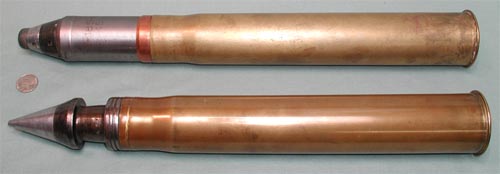
Soviet 45mm AT rounds, APBC (Top) and APCR (Bottom)
|
After 1943 the Germans had very few
rounds left, although there are stories of crews being issued with one
or two rounds when JS2s were expected.
The Russians seem to have rationed their “arrows” to 4 per tank. I
can’t find any info on APDS availability for British units, and
although there seems to have been plenty of 6pdr APDS for the anti tank
batteries (and some of it made its way into US hands for use in their
57mm AT gun).
|
Last Updated On Friday, August 22, 2008 by Wayne at Battlefront
|
|
|